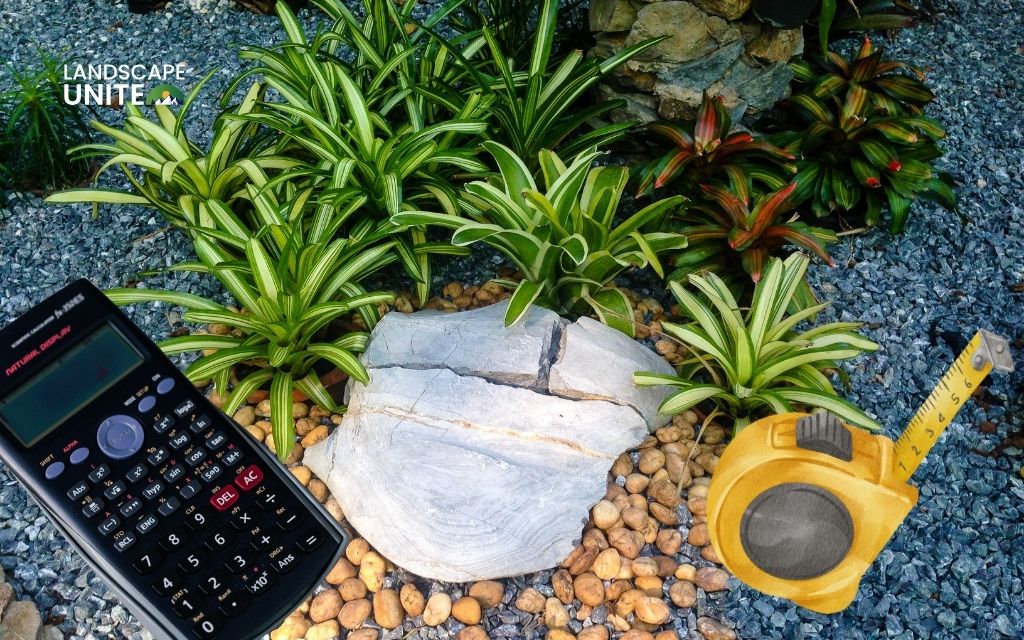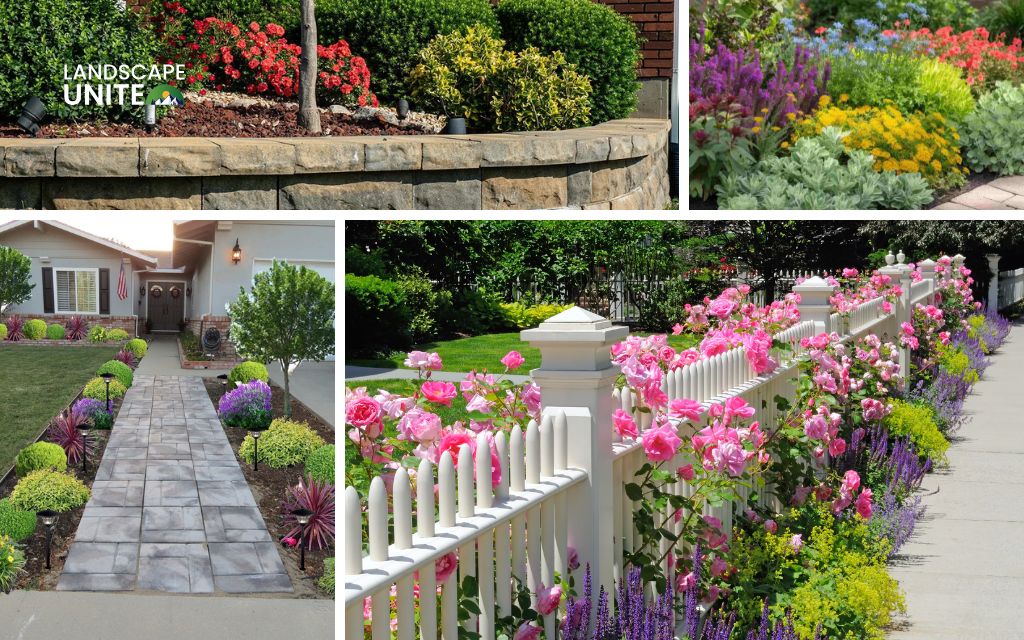Those unsightly brown and orange stains covering your concrete driveway after fall cleanup? You’re not alone. The beautiful autumn season brings stunning foliage, but it also leaves behind stubborn leaf stains that can make your concrete surfaces look neglected and worn.
The good news is that knowing how do you remove leaf stains from concrete doesn’t require expensive professional equipment or harsh chemicals. With the right approach, most homeowners can restore their concrete surfaces for a beautiful landscape by using common household items and proven techniques.
Why do leaves stain concrete?
Leaf stains come from tannins, natural organic compounds found in leaves. These are the same compounds that give tea its color and contribute to the rich hues of autumn foliage.
When wet leaves sit on concrete, these tannins leach out and react with the surface, leaving brown or rust-like marks. The process accelerates during fall and after rain, when moisture acts as a catalyst for the chemical reaction between tannins and concrete.
The tannins essentially dye the concrete from within, which is why surface rinsing alone rarely works. The longer leaves remain in contact with moist concrete, the deeper the tannins penetrate, making older stains more challenging to remove.
Identify the stain type and severity
Before jumping in with cleaning solutions, take a moment to assess how deep the stain has penetrated. This evaluation determines which removal method will be most effective and saves you time by starting with the appropriate treatment intensity.
| Stain Type | Description | Best Treatment |
| Light surface stain | Fresh, shallow brown mark | Soap + water scrub |
| Moderate stain | Slightly absorbed, visible after rinsing | Oxygen bleach or vinegar |
| Deep or old stain | Dark, set-in mark | Concrete cleaner or pressure washing |
- Light surface stains appear as fresh, shallow brown marks that have had minimal time to absorb into the concrete. These usually respond well to simple cleaning methods.
- Moderate stains show slight absorption and remain visible even after rinsing with water – they’ve begun penetrating the surface but haven’t fully set.
- Deep or old stains present as dark, set-in marks that resist water rinsing entirely, indicating significant tannin absorption.

How to prepare for stain removal
Clear the area
Remove all leaves, dirt, and debris using a broom or leaf blower.
Pay special attention to corners, edges, and textured surfaces where organic material tends to accumulate. Getting a completely clean surface allows you to see where the stains are located and prevents you from pushing debris around while scrubbing.
Let the concrete dry completely to easily see where stains remain. This drying period also gives you time to gather supplies and plan your approach.
Gather cleaning supplies
Having everything ready before you start saves multiple trips and keeps your workflow efficient:
- Bucket and warm water
- Dish soap, vinegar, baking soda, or oxygen bleach
- Nylon scrub brush
- Gloves, goggles, and protective clothing
- Garden hose or pressure washer
Protect nearby plants and surfaces
Wet surrounding soil and plants thoroughly before applying cleaners. This dilutes any cleaning solution that might run off and reduces the concentration that reaches plant roots. Even mild cleaners can affect sensitive plants if applied in concentrated form.
Cover fragile plants, newly planted flowers, or vegetables if using stronger chemicals or pressure washing. A simple tarp or plastic sheeting secured with stones works perfectly.
Also consider the drainage pattern – where will your rinse water go? Redirect downspouts or create barriers if runoff will flow toward landscape beds you want to protect.
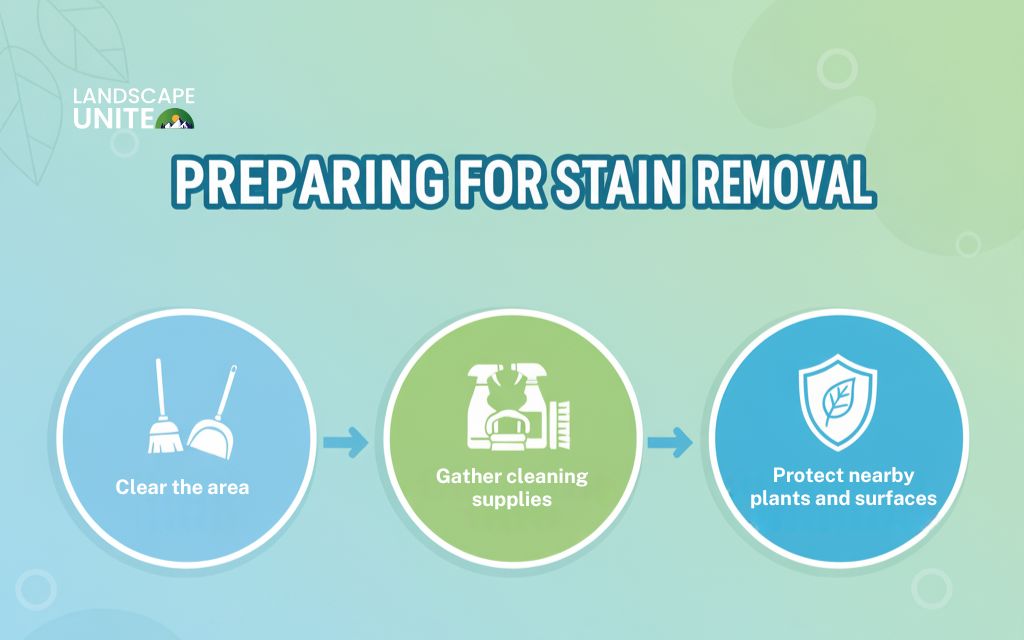
How do you remove leaf stains from concrete? 5 proven methods
Each method builds in strength – start mild, then move to stronger solutions if needed. This progressive approach protects your concrete from unnecessary chemical exposure while ensuring effective stain removal.
Method 1: Soap and water
This gentle approach works well on fresh stains and should always be your first attempt. It’s safe, inexpensive, and requires only common household items.
You’ll need:
- Bucket
- Warm water
- Mild dish soap
- Stiff nylon brush
Instructions:
- If you’re dealing with leaves that fell yesterday, this simple approach often eliminates stains completely.
- Mix warm water with a few drops of dish soap in your bucket, creating a light lather. The soap helps break down the tannin molecules and warm water enhances penetration into the concrete pores.
- Scrub the stained area in circular motions using firm, consistent pressure. Work from the outer edges of the stain toward the center to avoid spreading tannins to clean areas.
- The nylon bristles should be stiff enough to work the solution into the concrete without scratching the surface.
- Rinse with clean water, using a hose or additional buckets of fresh water to remove all soap residue. Soap left to dry can create its own staining or attract dirt.
- Repeat as needed for newer stains. Sometimes a second or third application removes what the first loosened.

Method 2: Baking soda paste
You’ll need:
- ½ cup baking soda
- Small amount of water (start with 2-3 tablespoons to form a thick paste)
- Scrub brush
- Garden hose or bucket of clean water
Instructions:
- For persistent stains, create a fresh batch and repeat. Each application will progressively lighten the stain even if it doesn’t remove it entirely on the first attempt.
- Mix baking soda and water into a thick, spreadable paste with a consistency similar to toothpaste.
- Apply directly to stained areas using a trowel, old spatula, or gloved hand. Spread the paste in a layer about ¼-inch thick, ensuring complete coverage of the discolored area and extending slightly beyond the stain’s edges.
- Let sit for 20-30 minutes. In hot weather, the paste may begin to dry; lightly mist it with water to keep it active. You want it to remain moist but not runny.
- Scrub gently with a nylon brush using circular motions. The paste will start to form a slurry.
- Rinse thoroughly with clean water, ensuring all baking soda residue is removed. Any remaining powder will create a white film that can be mistaken for discoloration.

Method 3: White vinegar or lemon juice
For homeowners who prefer natural cleaning solutions, acidic ingredients like vinegar and lemon juice offer effective stain removal without harsh chemicals. The mild acidity breaks down tannins while remaining safe for surrounding vegetation.
You’ll need:
- Undiluted white vinegar or lemon juice
- Spray bottle
- Scrub brush
Instructions:
- Spray vinegar directly on the stained area, saturating the stain completely.
- Don’t dilute the vinegar – full-strength acidity provides optimal tannin-breaking power. For larger areas, pour vinegar directly from the bottle rather than using a spray bottle.
- Let it sit for 15 – 30 minutes. During this dwell time, the acetic acid in vinegar penetrates the concrete pores and begins dissolving the tannin bonds. You may notice slight fizzing or color change, which indicates the chemical reaction is working.
- Scrub gently and rinse clean with plenty of water. The stain should lift more easily after the vinegar treatment than it would with water alone.
- Repeat if necessary. Stubborn moderate stains may require 2 or 3 applications, allowing the concrete to dry between treatments so you can assess remaining discoloration.
The mild acid won’t harm established plants, though you should still rinse surrounding vegetation with water as a precaution.
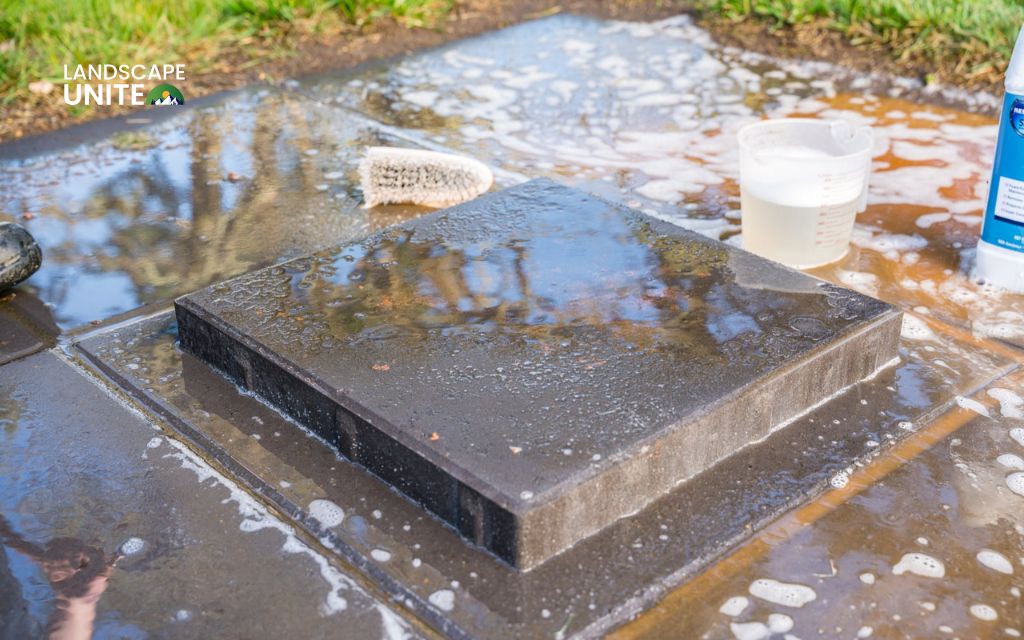
Method 4: Oxygen bleach
When natural methods fall short, oxygen bleach provides powerful cleaning action without the risks associated with chlorine bleach. This is often the sweet spot for homeowners tackling stains that are weeks or even months old.
You’ll need:
- Oxygen bleach (sodium percarbonate, such as OxiClean)
- Warm water
- Bucket and brush
Instructions:
- Mix according to package instructions, typically combining oxygen bleach powder with warm water. The warm temperature activates the sodium percarbonate, releasing oxygen molecules that break down organic stains.
- Standard ratios range from 1-2 tablespoons per gallon of water, but follow your specific product’s guidelines.
- Pour solution over the stained area, ensuring complete coverage. For vertical surfaces or areas where liquid might run off, create a paste consistency by using less water, then spread it onto the stain.
- Let it sit for 10 – 15 minutes but don’t let it dry. The active oxygen molecules work during this period, breaking down organic matter including tannins. If the solution begins drying before the time is up, mist it lightly with water to keep it active.
- Scrub and rinse thoroughly with plenty of clean water. You should see significant lightening of the stain. The concrete may appear slightly lighter while wet but will return to its normal color when dry.
Why it works:
Unlike chlorine bleach, which can discolor concrete and kill surrounding vegetation, oxygen bleach decomposes into harmless oxygen, water, and soda ash. This makes it safe for use around landscaping and on colored or decorative concrete.
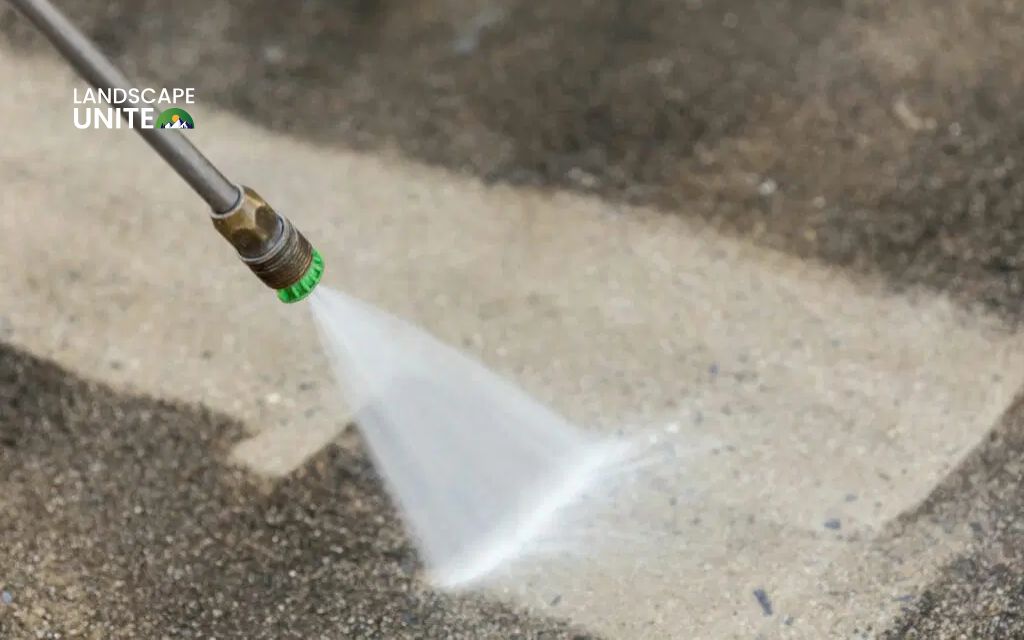
Method 5: Concrete cleaner or pressure washer
When all else fails, commercial concrete cleaners and pressure washing provide the heavy artillery for stain removal. This method is particularly for stains that have been present for months or cover large surface areas.
You’ll need:
- Commercial concrete cleaner (acid-free preferred) or pressure washer
- Stiff brush
- Safety gloves and goggles
Instructions:
- Apply cleaner as directed, scrubbing deeply into pores. Commercial concrete cleaners often contain surfactants and mild acids specifically formulated to break down organic stains without damaging concrete.
- Follow the manufacturer’s specific dwell time, which typically ranges from 5-20 minutes.
- Rinse thoroughly with high-pressure water. A pressure washer delivers concentrated force that dislodges deeply embedded tannins. Keep the nozzle moving in steady, overlapping passes to avoid creating clean streaks or etching patterns.
- For extreme cases, use a pressure washer alone at 1,500 – 2,500 PSI maximum. Hold the wand 12 – 18 inches from the surface at approximately a 45-degree angle.
- This distance and angle provide optimal cleaning power while minimizing the risk of surface damage.
Safety note: Always follow manufacturer safety guidelines. When using acidic cleaners, always wear protective gloves and eye protection, and never mix different cleaning products.

Dry and inspect
After cleaning, allow the surface to fully dry, which typically takes 24 hours depending on temperature, humidity, and sun exposure. Wet concrete appears darker than dry concrete, making it impossible to accurately assess stain removal while moisture remains.
Check for shadow stains or discoloration once the surface is completely dry. Sometimes what appears to be a remaining stain is actually just moisture trapped in the concrete pores, which will evaporate over the next day or two.
If a slight mark remains after drying, reapply your chosen cleaner once more. Often, what survives the first treatment is significantly weakened tannin bonding that a second application will eliminate.
Most stains fade completely after 1 – 3 treatments, with each successive application producing diminishing returns as less and less tannin remains.
How to prevent leaf stains on concrete
The most effective stain removal strategy is prevention. By implementing a few proactive measures, you can reduce or eliminate leaf staining before it starts.
Remove leaves promptly
Sweep or blow leaves every few days, especially after rain. Wet leaves accelerate tannin leaching, so prompt removal during fall’s rainy periods provides maximum protection.
Focus on areas where leaves accumulate in corners, along edges, or in textured surface patterns. Consider this part of your regular fall maintenance routine, like mowing the lawn or watering plants.
Apply a concrete sealer
Use a penetrating sealer to block tannins from soaking in. Quality concrete sealers create a protective barrier within the concrete’s pores, preventing moisture and tannins from penetrating while still allowing the concrete to breathe and release internal moisture vapor.
Improve drainage
Ensure water doesn’t pool under trees or around concrete surfaces. Standing water creates prolonged contact between leaves and concrete, maximizing tannin transfer.
Grade soil away from concrete edges, install or clean drainage systems, and consider cutting shallow drainage channels in areas prone to pooling.
Trim overhanging branches
Reduces leaf litter and moisture buildup that cause staining. Strategic pruning serves double duty by decreasing the volume of leaves falling onto concrete. Focus on branches over high-visibility areas like entryways and patios.
Use outdoor mats or ground covers
Especially in high-fall zones under trees or near gutters. Heavy-duty outdoor mats placed in known problem areas catch leaves before they contact concrete, making cleanup as simple as lifting and shaking the mat.
Similarly, ground covers like mulch or decorative stone in planting beds adjacent to concrete prevent leaf decomposition directly on the concrete surface.
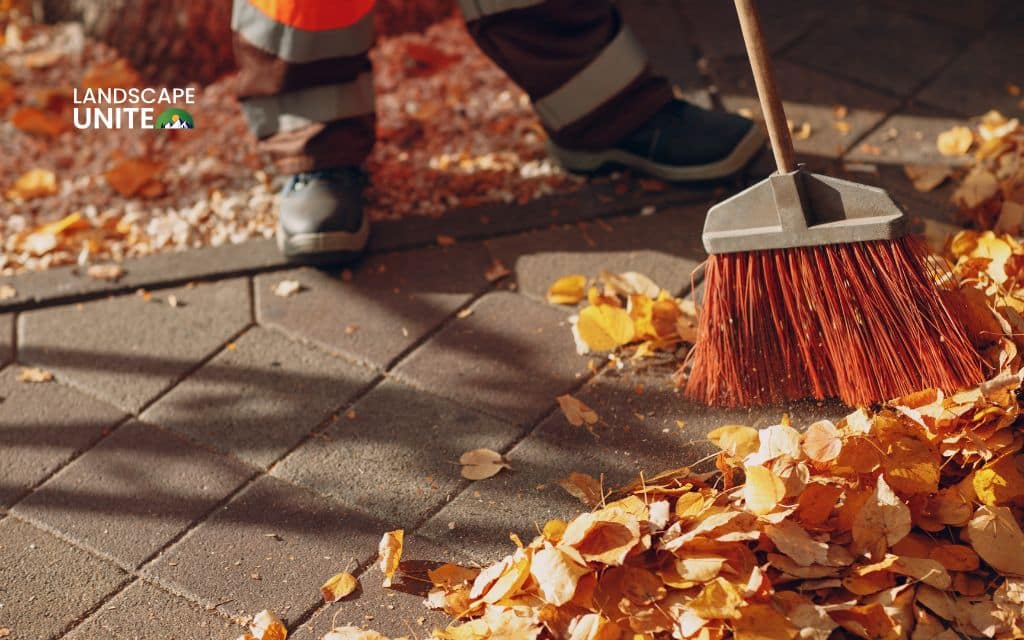
Common mistakes to avoid
Learning from others’ mistakes saves you time, money, and potential damage to your concrete. Here are the most frequent errors homeowners make when attempting to remove leaf stains:
- Using chlorine bleach: It can discolor or weaken concrete. While chlorine bleach might seem like a powerful stain fighter, it reacts with concrete’s lime content, creating permanent white or yellow discoloration. It also kills surrounding plants and grass indiscriminately.
- Scrubbing with wire brushes: They leave scratches and rust marks. Wire bristles are too aggressive for concrete’s surface, creating grooves that trap dirt and sometimes depositing rust particles that cause new stains.
- Ignoring moisture: Stains worsen when surfaces stay damp. Address moisture sources like poor drainage, excessive irrigation, or lack of sunlight as part of your stain prevention strategy.
- Leaving cleaning solutions to dry out: Any cleaning product left to evaporate on concrete can leave behind concentrated residue that attracts dirt or creates its own discoloration.
- Using power washers too close: The intense pressure of a power washer held too near the surface literally blasts away concrete material, creating permanent damage that looks worse than the original stain.
Conclusion
Learning how do you remove leaf stains from concrete empowers you to maintain beautiful, clean concrete surfaces year-round. Removing leaf stains from concrete doesn’t have to be an overwhelming challenge. By understanding why these stains occur, assessing their severity, and selecting the appropriate removal method for your situation, you can restore your concrete surfaces to their original appearance. Start with the gentlest approach suitable for your stain type, and remember that patience and proper technique often matter more than aggressive chemical application.
Landscape Unite provides comprehensive landscaping, hardscaping, and gardening information to help homeowners make informed decisions about their outdoor spaces. From Mile High Lifescape, we’re committed to sharing expert knowledge that helps you achieve outstanding results.
Frequently asked questions (FAQs)
Will bleach remove leaf stains from concrete?
Oxygen bleach works effectively and safely on concrete. Avoid chlorine bleach, which can discolor and weaken concrete surfaces. Always test cleaning products in inconspicuous areas first.
Can leaf stains permanently damage concrete?
Tannin stains are primarily cosmetic and don’t structurally damage concrete. However, long-term neglect can lead to surface deterioration. Prompt treatment prevents permanent discoloration.
What’s the best time of year for concrete stain removal?
Spring offers ideal conditions in Denver, with mild temperatures and minimal leaf fall. Avoid summer heat that causes cleaners to dry too quickly and winter freezing that reduces cleaning effectiveness.
How often should I clean leaf stains from concrete?
Address stains within 2-3 weeks for easiest removal. During heavy leaf season, weekly maintenance prevents buildup. For comprehensive maintenance schedules, read our seasonal concrete care guides.
Are commercial concrete cleaners worth the extra cost?
For stubborn stains that resist DIY methods, commercial cleaners offer specialized formulations that save time and effort. Choose products specifically designed for concrete surfaces to avoid damage.
